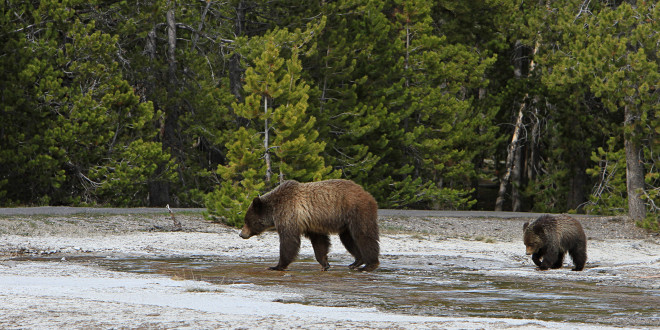The Endangered Species Coalition has listed Yellowstone grizzly bears in its report concerning species marooned in fragmented habitats.
The report, entitled “No Room to Roam: 10 American Species in Need of Connectivity and Corridors,” focuses on ten species who are impacted by national infrastructure, ranging from roads to fences and dams.
The report, signed by representatives from the American Bird Conservancy, Center for Biological Diversity, Natural Resources Defense Council, and The Center for Plant Conservation, among others, aims to persuade policy makers regarding management decisions, in light of historic declines and projected losses in species stability and viability.
The report highlights Yellowstone grizzly bears as one of two remnant populations in the lower 48 states—the other lives in Glacier National Park—of bears whose range once stretched across the west, north to Canada and down to Mexico. Bears were largely extirpated from the lower 48 by the turn of the 20th century. Grizzly bears were listed under the Endangered Species Act in 1975. Yellowstone grizzly bears have been isolated from other species for over a century.
The ten species listed in the report also include California tiger salamanders and the Karner blue butterfly, among others. You can read the full report here but here’s a quote from the introduction:
This report details the stories of some of the U.S. species most in need of the right to roam. Without wildlife corridors, migration routes, and other connected habitat, wildlife cannot continue to reproduce, find food, disperse, and maintain enough diversity in their populations to survive into the future. Thankfully, we’ve begun to create solutions for wildlife. But much more must be done. Read on and reach out to help decision-makers to help.
The report comes on the heels of possible discussion over delisting Yellowstone grizzly bears, as well as a study saying Yellowstone grizzly bears were stable, if not recovered. Tribal representatives recently voiced their opposition to a potential delisting. And the decision comes after an apparent increase in grizzly mortalities this year.
“You don’t have to be a scientist to understand that declining population, loss of food sources, and isolation from other bears are threats to the long-term survival of the Yellowstone grizzly. Yet the U.S. Fish and Wildlife Service is poised to remove these bears from the endangered species list, an action that would likely leave the population isolated forever,” said Sylvia Fallon, a Senior Scientist with the Natural Resources Defense Council (NRDC) in a press release.
Fallon added: “To remain viable, this population of grizzlies needs a secure future with a diversity of food sources and an effective plan to help people and bears avoid conflicts. And, above all, the bears need the freedom to roam so they can maintain genetic diversity by breeding with other grizzly bear populations found to the north and west.”
Indeed, delisting Yellowstone grizzly bears has the potential to complicate bear management, which would pass over to the states. Although nothing would change in Yellowstone National Park, it would change how bears are treated in the Greater Yellowstone Ecosystem, beyond the boundary of federal lands.
 Yellowstone Insider Your Complete Guide to America's First National Park
Yellowstone Insider Your Complete Guide to America's First National Park





